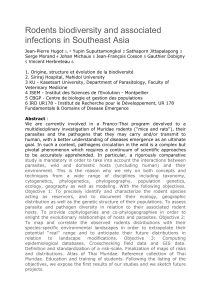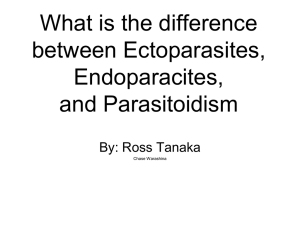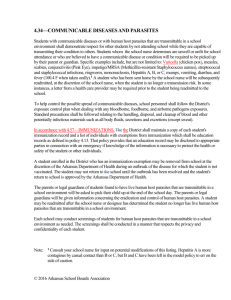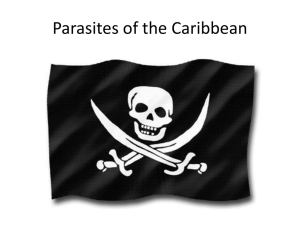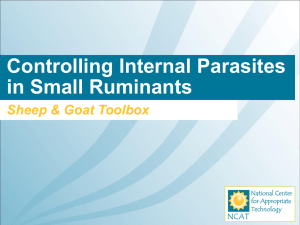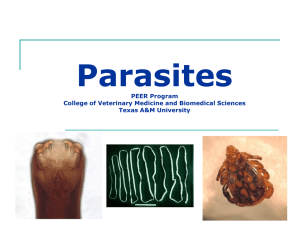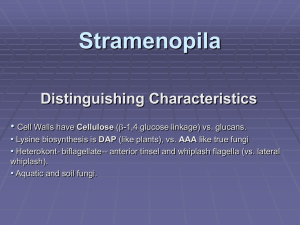Electronic Supplementary Materials
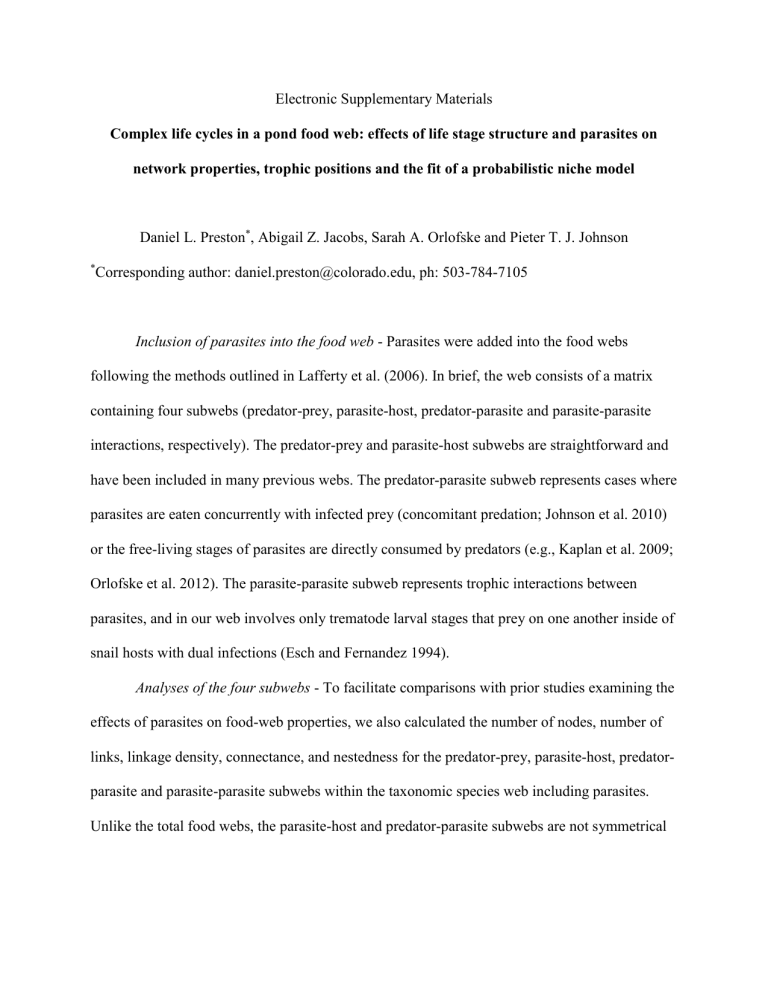
Electronic Supplementary Materials
Complex life cycles in a pond food web: effects of life stage structure and parasites on network properties, trophic positions and the fit of a probabilistic niche model
Daniel L. Preston
*
, Abigail Z. Jacobs, Sarah A. Orlofske and Pieter T. J. Johnson
*
Corresponding author: daniel.preston@colorado.edu, ph: 503-784-7105
Inclusion of parasites into the food web - Parasites were added into the food webs following the methods outlined in Lafferty et al. (2006). In brief, the web consists of a matrix containing four subwebs (predator-prey, parasite-host, predator-parasite and parasite-parasite interactions, respectively). The predator-prey and parasite-host subwebs are straightforward and have been included in many previous webs. The predator-parasite subweb represents cases where parasites are eaten concurrently with infected prey (concomitant predation; Johnson et al. 2010) or the free-living stages of parasites are directly consumed by predators (e.g., Kaplan et al. 2009;
Orlofske et al. 2012). The parasite-parasite subweb represents trophic interactions between parasites, and in our web involves only trematode larval stages that prey on one another inside of snail hosts with dual infections (Esch and Fernandez 1994).
Analyses of the four subwebs - To facilitate comparisons with prior studies examining the effects of parasites on food-web properties, we also calculated the number of nodes, number of links, linkage density, connectance, and nestedness for the predator-prey, parasite-host, predatorparasite and parasite-parasite subwebs within the taxonomic species web including parasites.
Unlike the total food webs, the parasite-host and predator-parasite subwebs are not symmetrical
and connectance is defined as C = L /( F * P ), where F is the number of free-living species and P is the number of parasites (Lafferty et al. 2006).
Food webs lacking concomitant links For consistency with other work (Dunne et al.
2013), we present results from analyses conducted on versions of the web that included parasites but lacked concomitant predation links. In these webs, connectance was calculated as both the traditional measure ( C = L / S
2
), where L is the number of links and S is the total number of nodes in the web, and as adjusted connectance ( C = L /( F*S )); Lafferty et al. 2006), where F is the number of free-living species. The adjusted connectance measure slightly overestimates connectance in these web versions because it excludes all predator-parasite links, whereas only concomitant predation links are actually omitted in the food web.
Table S1 . Food web properties for web versions with parasites but lacking concomitant links.
Note that connectance is represented as both the traditional measure (outside parentheses) and as adjusted connectance (inside parentheses).
Number of Nodes
Observed Links
Linkage Density
Connectance
Clustering Coefficient
Nestedness (N*)
Nestedness (NODF)
Mean Trophic Level
Fraction Omnivores
Mean Consumer Gaps
Mean Diet Range Gaps
PNM Results f
L
Expected links
Observed links
Taxonomic
Species Web
63
891
14.1
0.22 (0.29)
0.57
1.3
37.5
4.4
0.83
7.2
7.6
0.60
896
891
Niche Shift
Web
105
984
10.0
0.09 (0.15)
0.49
0.5
17.2
3.6
0.91
6.4
6.5
0.54
1083
1055
Life Stage
Web
113
1317
12.5
0.10 (0.16)
0.54
0.7
20.1
3.7
0.92
7.7
7.7
0.51
1403
1409
Table S2. Summary metrics for each of the four sub-webs and the total taxonomic species web.
Parameter
Species Richness (S)
Potential Links (L p
)
Observed Links (L)
Linkage Density (L/S)
Connectance (C)
Nestedness (N*)
Nestedness (NODF)
Total
Food Web
63
3969
1088
17.3
27.4
2.1
49.9
Predator-
Prey
48
2304
597
12.4
25.9
1.3
40.3
Parasite-
Host
63
720
87
1.4
12.1
0.2
14.3
Predator-
Parasite
63
720
388
6.2
53.9
1.2
61.5
Literature Cited
Dunne JA, Lafferty KD, Dobson AP, Hechinger RF, Kuris AM, Martinez ND,
Parasite-
Parasite
15
225
16
1.1
7.1
1.0
8.6
McLaughlin JP, Mouritsen KN, Poulin R, Reise K, Stouffer DB, Thieltges DW, Williams
RJ, Dieter Zander C (2013) Parasites affect food web structure primarily through increased diversity and complexity. PLOS Biol 11: e1001579
Esch GW, Fernandez JC (1994) Snail-trematode interactions and parasite community dynamics in aquatic systems: a review. Amer Midl Nat 131: 209-237
Johnson PTJ, Dobson A, Lafferty KD, Marcogliese DJ, Memmott J, Orlofske SA, Poulin
R, Thieltges DW (2010) When parasites become prey: ecological and epidemiological significance of eating parasites Trends Ecol Evol 25: 362-371
Kaplan AT, Rebhal S, Lafferty KD, Kuris AM (2009) Small estuarine fishes feed on large trematode cercariae: lab and field investigations. J Parasitol 95: 477-480
Lafferty KD, Hechinger RF, Shaw JC, Whitney K, Kuris AM (2006) Food webs and parasites in a salt marsh ecosystem. In Collinge S, Ray C (eds) Disease ecology: community structure and pathogen dynamics. Oxford University Press, Oxford, pp 119-
134
Orlofske SA, Jadin RC, Preston DL, Johnson PTJ (2012) Parasite transmission in complex communities: predators and alternative hosts alter pathogenic infections in amphibians. Ecology 93: 1247-1253
